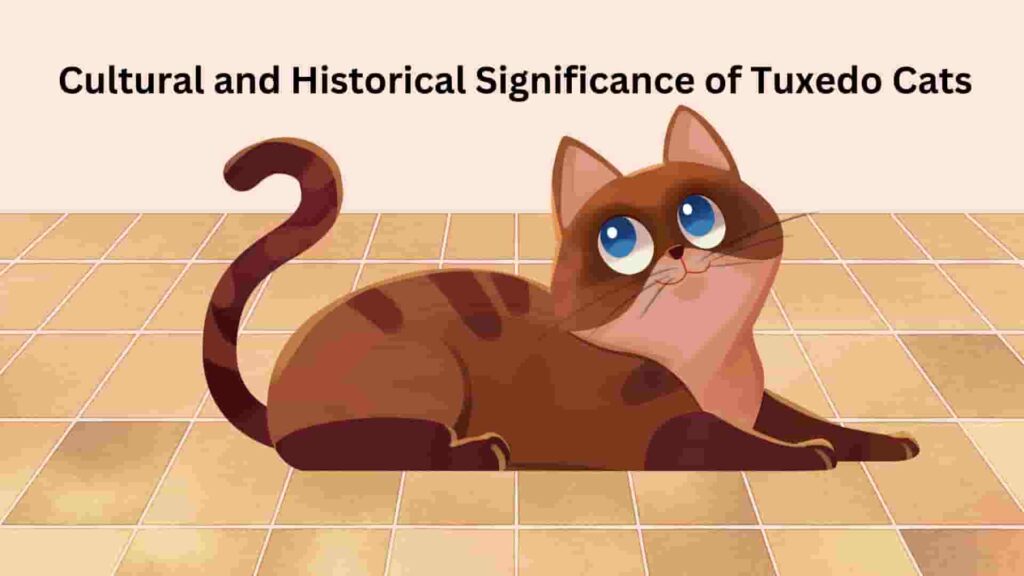The Unique Appeal of Tuxedo Cat
Tuxedo cats, characterized by their distinctive black and white fur, mirror the look of formal attire, which is why they’re affectionately known as tuxedo cats. Their striking appearance and engaging personalities make them particularly captivating.
These felines are more than just their elegant markings; they are known for their playful and affectionate demeanor.
Contrary to some superstitions surrounding black cats, tuxedo cats are often seen as bearers of good luck and are beloved for their friendly and loyal nature.
When it comes to care, tuxedo cats require the same attention as any other cat, including regular health check-ups, a balanced diet, and plenty of interaction. Their sociable nature makes them excellent companions, thriving in environments where they can connect with people.
In summary, the special charm of tuxedo cats goes beyond their sophisticated coat. It’s their vibrant personalities and the positive energy they bring to their families that truly make them special pets.
Whether you’re an experienced pet owner or thinking about adopting your first cat, tuxedo cats are a delightful choice.
Unveiling the Allure of Black and White Cats
Black and white cats, often referred to as tuxedo cats, captivate with their distinct two-tone coloration that mirrors the elegance of formal wear. This pattern is not exclusive to any one breed but appears across various cat breeds.

These cats are celebrated for their engaging and amiable personalities, making them beloved companions among cat enthusiasts. Known for their intelligence and affection, tuxedo cats excel in social interactions and adaptability.
Understanding Tuxedo Cats
While commonly called tuxedo cats due to their black and white coats resembling a suit, this coloration spans across multiple breeds including the American Shorthair, British Shorthair, and Maine Coon.
The term “tuxedo” broadly categorizes any cat with this striking black and white pattern, regardless of breed, enhancing their charm with their sophisticated appearance.
Diversity in Bicolor Cats
Though tuxedo cats are predominantly black and white, the bicolor category also includes other color variations such as gray and white, orange and white, and calico. The primary allure lies in the vivid contrast these colors present, each bicolor cat boasting a unique and eye-catching look.
Bicolor Patterns Explained
Bicolor patterns range from minimal white markings to nearly all-white bodies with just a few color spots. Notable patterns include:
- Locket: Characterized by a small white patch on the chest.
- Standard Bicolor: Features a balanced distribution of white and a secondary color.
- Mask-and-Mantle: Resembles wearing a colored mask and cape, with more color than white.
- Cap-and-Saddle: Displays a colored “cap” on the head and a small colored “saddle” on the back.
- Harlequin: Predominantly white with random colored spots.
- Van: Mainly colored between the ears and on the tail, with the rest of the body white.
Each pattern provides a distinctive visual appeal, showcasing the diversity and beauty of bicolor cats.
The Personality of Tuxedo Cats
Tuxedo cats are not just a pleasure to look at but are also known for their dynamic and sociable personalities. They typically display high levels of playfulness and intelligence, making them not only fun but also easy to train. Their affectionate nature helps them create strong bonds with their owners, adding to their reputation as fantastic pets.
Read more: The Personality of Tuxedo Cats
In essence, the special charm of black cats with white chests lies not only in their striking appearance but also in their vibrant personalities, making them a top choice for anyone looking to enrich their life with a feline companion.
What Makes a Black Cat with a White Chest Special? Unveiled
Genetic Traits in Tuxedo Cats
Unlike calico and tortoiseshell cats, where genetics dictate both color patterns and gender—typically resulting in female cats—tuxedo cats show no such gender preference.
The iconic black and white coloring of tuxedo cats stems from genetic factors that are unrelated to gender, leading to an even distribution of both male and female tuxedo cats.
This pattern can appear in any offspring if the necessary genes for black and white fur are present, making it uniquely independent from gender-linked genetic traits.
Tuxedo Cats in Media
Tuxedo cats are famously known as Felix cats due to the classic cartoon character, showcasing their significant role in media. These cats are commonly featured in television, video games, and movies, demonstrating their widespread appeal.
Significant Appearances Include
- Television: Characters like Felix the Cat, Sylvester, Tom, The Cat in the Hat, and Mr. Mistoffelees.
- Video Games: Notable characters include Cait Sith, Rover, Morgana, Big the Cat, and Unsinkable Sam.
- Movies: Appearances in films like The Nine Kittens of Christmas, Luca, John Wick: Chapter 3, and more.
Cultural and Historical Significance of Tuxedo Cats
Beyond their charm and intelligence, tuxedo cats have been favored by historical figures and have held a significant place in various cultures.

Notable Owners
- William Shakespeare and Sir Isaac Newton both owned tuxedo cats, enhancing their historical allure.
- Socks, a tuxedo cat, famously resided in the White House as the First Cat during the Clinton administration.
Ancient Heritage
In ancient Egypt, cats were venerated as deities, not merely pets, with tuxedo cats frequently depicted in art from around 3200 BC, highlighting their esteemed status.
Also read: What-makes-dogs-scream-5-critical-pain-signals
Wealth and Legacy
Tuxedo cats have not only won hearts with their appealing looks but have also been known for their substantial inheritances. For instance, Sparky, a tuxedo cat, was once deemed the world’s richest cat after inheriting $6.3 million. This demonstrates the remarkable legacies that some pets can inherit, although this record was later surpassed by another fortunate feline.
The Unique Appeal of Black Cats with White Chests
Mythical Attributes of Tuxedo Cats
There’s a whimsical belief that tuxedo cats possess the ability to become invisible during the equinoxes, enhancing their mysterious and enchanting nature. Although this is purely folklore, such tales add to the mystical allure of these distinctively patterned felines, making them a fascinating subject in popular culture.
Commonality of Tuxedo Cats
Tuxedo cats are relatively widespread, with their black and white coats being a common sight among domestic cats, which dispels the notion of their rarity.
Health Aspects of Tuxedo Cats
These cats are generally healthy, with no specific genetic conditions linked to their black and white coloring. Like all cats, maintaining their health involves regular veterinary visits and a healthy lifestyle.
Lifespan of Indoor Tuxedo Cats
When kept indoors, tuxedo cats can live between 12 to 20 years. A nurturing home environment, coupled with regular care, significantly contributes to their longevity.
Preferences for Affection in Tuxedo Cats
While many tuxedo cats enjoy human affection and being held, their preference can vary based on their personality and upbringing. Positive socialization plays a crucial role in their comfort with handling.
Distinctive Qualities of Tuxedo Cats
What sets tuxedo cats apart is their sophisticated black and white coat, which resembles formal attire, adding to their charm. Their frequent depiction in media, along with their sociable, smart, and affectionate nature, makes them particularly beloved.
Intelligence of Tuxedo Cats
Tuxedo cats are noted for their impressive intelligence, demonstrating capabilities in problem-solving and adaptability that make them delightful companions.
Eye Colors of Tuxedo Cats
These cats display a range of eye colors, including golden, green, or blue, depending on their genetic makeup, which adds to their striking visual appeal.
Care Guidelines for Tuxedo Cats
To properly care for a tuxedo cat, ensure regular veterinary check-ups, provide a balanced diet, engage in regular grooming, and offer ample playtime to keep them active and healthy.
Also read: How-to-properly-measure-dog-food
Training Tips for Tuxedo Cats
Training a tuxedo cat involves simple, focused sessions with minimal distractions and immediate rewards. Consistency in cues and timing is essential for effective learning, and positive reinforcement should be prioritized over punishment.
Conclusion
Tuxedo cats, with their iconic black and white coats, are more than just visually appealing—they are affectionate, intelligent, and an integral part of many families and cultural narratives. Their presence is cherished by those who appreciate their companionship and unique personality traits.
FAQ’s:
What breed of cat is a tuxedo cat?
Tuxedo cats are not a distinct breed; instead, they are recognized by their black and white color pattern which can appear in various cat breeds.
Are tuxedo cats aggressive?
Generally, tuxedo cats are known for being friendly and do not exhibit aggressive behavior.
Are tuxedo cats expensive?
The price of a tuxedo cat depends on the breed rather than the color pattern.
